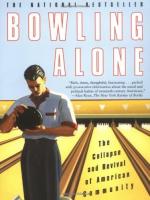
|
| Name: _________________________ | Period: ___________________ |
This test consists of 15 multiple choice questions and 5 short answer questions.
Multiple Choice Questions
1. In 1995 how many Americans volunteered?
(a) 71 million.
(b) 68 million.
(c) 93 million.
(d) 86 million.
2. What did sociologists Claude Fischer and Robert Jackson call single-stranded interactions that began to take place in America?
(a) Individual communities.
(b) Communities of one.
(c) Communities of limited liability.
(d) Personal communities.
3. Who said "80 percent of life is simply showing up"?
(a) Bob Hope.
(b) Sid Caesar.
(c) Woody Allen.
(d) Bill Cosby.
4. How much more common is philanthropy and volunteering in American than in other countries?
(a) 1/2.
(b) Twice as common.
(c) Three times as common.
(d) 1/4.
5. When was the PTA founded?
(a) 1910.
(b) 1912.
(c) 1921.
(d) 1923.
6. In the last two decades of the twentieth century, by what fraction did unlisted phone numbers grow?
(a) By 1/4.
(b) By 2/3.
(c) By 1/2.
(d) By 1/3.
7. In the late twentieth century, how many more times would an American send a greeting card to a friend than a letter to the editor?
(a) 28.
(b) 35.
(c) 43.
(d) 57.
8. In 1985, of the 205 national citizens groups in existence, how many had chapters to which individual members belonged and paid dues?
(a) Less than 1/4.
(b) Less than 1/3.
(c) Less than 1/2.
(d) Less than 3/4.
9. During what time was there explosive growth in union membership?
(a) During the Depression.
(b) After World War II.
(c) During the New Deal.
(d) During the Cold War.
10. In what year were Americans split about fifty-fifty on the issue whether society was as upright morally as it has been in the past?
(a) 1932.
(b) 1961.
(c) 1952.
(d) 1943.
11. What publication ran an article about the challenge of free time and Americans in 1964?
(a) Newsweek.
(b) New Yorker.
(c) Wall Street Journal.
(d) Time.
12. How much had states spent on "motor voter" registration?
(a) $100 million.
(b) $58 million.
(c) $79 million.
(d) $45 million.
13. When did party finances skyrocket?
(a) 1980s and 1990s.
(b) 1960s and 1970s.
(c) 1940s and 1950s.
(d) 1970s and 1980s.
14. In the 1990s, how many women worked outside the home?
(a) 3 out of 4.
(b) 4 out of 5.
(c) 1 out of 2.
(d) 2 out of 3.
15. How many more long distance calls to family and friends would women make than men?
(a) 5-10 percent.
(b) 10-20 percent.
(c) 20-30 percent.
(d) 30-40 percent.
Short Answer Questions
1. In the 1990s, how many Americans moved?
2. When were members playing regularly in the bridge club Putnam mentioned in Chapter 1?
3. Between 1986-86 and 1998-99, how much of a decline was there in the number of average Americans who made new friends?
4. When do most scholars agree that church membership was most likely at an all-time high?
5. How many organizations did Putnam find listed in the "World Alamanc"?
|
This section contains 371 words (approx. 2 pages at 300 words per page) |

|




